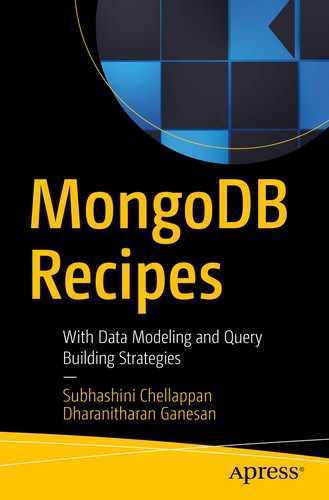MongoDB Recipes
With Data Modeling and Query Building Strategies

Why This Book?
Introduction to NoSQL databases, features of MongoDB, and installation procedures
Complete CRUD operations and MongoDB query language examples
Demonstrations of the aggregation framework to group data and perform aggregation operations
Indexing details to improve the performance of a query
Replication and sharding features to increase data availability and avoid data loss in case of a failure
Monitoring the database and backup strategies
Security features to implement proper authentication and authorization
Who Is This Book For?
The audience for this book includes all levels of IT professionals and anyone who wants to get a good understanding of MongoDB.
How Is This Book Organized?
Chapter 1 describes NoSQL databases, various features of MongoDB, the installation procedure, and how to interact with MongoDB.
Chapter 2 describes MongoDB’s rich query language to support create, read, update, and delete (CRUD) operations.
Chapter 3 describes the aggregation framework to perform aggregation operations. The aggregation framework can group data and perform a variety of operations on that grouped data.
Chapter 4 describes indexes, types of index, index properties, and the various indexing strategies to be considered. Indexes are used to improve the performance of a query.
Chapter 5 describes the various replication and sharding strategies in MongoDB. Replication is the process of creating and managing a duplicate version of a database across servers to provide redundancy and increase the availability of data. Sharding distributes data across servers to increase availability.
Chapter 6 describes the multi-document transactions feature. Multi-document transactions help us to achieve all-or-nothing execution to maintain data integrity.
Chapter 7 describes the details of various tools to monitor a MongoDB database and procedures for backup operations. These MongoDB monitoring tools help us to understand what is happening with a database at various levels.
Chapter 8 describes the various security features in MongoDB to verify the identity of the user and access controls to determine the verified user’s access to resources and operations.
How Can I Get the Most Out of This Book?
Subhashini Chellappan
Dharanitharan Ganesan
The making of this book was a journey that we are glad we undertook. The journey spanned a few months, but the experience will last a lifetime. We had our families, friends, colleagues, and other well-wishers onboard for this journey and we wish to express our deepest gratitude to each one of them.
We would like to express our special thanks to our families, friends, and colleagues who provided the support that allowed us to complete this book within a limited time frame.
Special thanks are extended to our technical reviewers for the vigilant review and filling in with their expert opinion.
We would like to thank Celestin Suresh John at Apress for signing us up for this wonderful creation. We wish to acknowledge and appreciate all our coordinating editors and the team who guided us through the entire process of preparation and publication.
Table of Contents
About the Authors and About the Technical Reviewer
About the Authors

is a technology enthusiast with expertise in the big data and cloud space. She has rich experience in both academia and the software industry. Her areas of interest and expertise are centered on business intelligence, big data analytics, and cloud computing.

has an MBA in technology management with high level of exposure and experience in big data—Apache Hadoop, Apache Spark, and various Hadoop ecosystem components. He has a proven track record of improving efficiency and productivity through the automation of various routine and administrative functions in business intelligence and big data technologies. His areas of interest and expertise are centered on machine learning algorithms, blockchain in big data, statistical modeling, and predictive analytics.
About the Technical Reviewer

has been working in the software industry for nearly 20 years. He holds an engineering degree from COEP, Pune (India) and since then has enjoyed an exciting IT journey.
As a Principal Architect at TatvaSoft, Manoj has undertaken many initiatives in the organization ranging from training and mentoring teams leading the data science and machine learning practice, to successfully designing client solutions from different functional domains.
Starting as a Java programmer, he is one of the fortunate to have worked on multiple frameworks with multiple languages as a full-stack developer. In last five years, he has worked extensively in the field of business intelligence, big data, and machine learning with the technologies like Hitachi Vantara (Pentaho), Hadoop ecosystem, tensorflow, Python-based libraries, and more.
He is passionate about learning new technologies, trends, and reviewing books. When he is not working, he is either working out or reading infinitheism literature.
Manoj would like to thank Apress for providing this opportunity to review this title and his two daughters Ayushee and Ananyaa for their understanding during the process.
